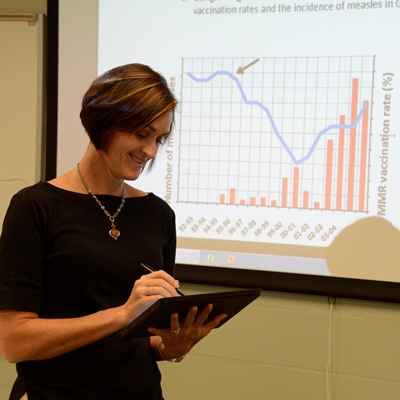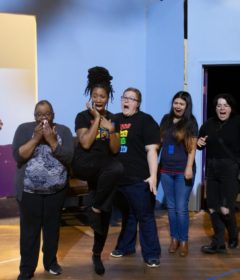SCALE-UP classroom opens 9-25
Ribbon-cutting of Stetson’s new SCALE-UP classroom:
Wednesday, Sept. 25, 2 p.m., Sage Science Center, room 222
“Stetson is a place that encourages faculty to dream,” said biology professor, Alicia Schultheis, pictured left. That is exactly what Dr. Schultheis did. She dreamed of creating a learning environment for a diverse group of students to impact their educational growth. Dr. Schultheis strongly expresses the importance of learning, as opposed to retaining information through lectures. She aspires to create an environment that is beneficial to students in a way that allows them to restore knowledge in their long-term memory. “While lecturing is a very efficient way for professors to teach, research shows that interactive learning is an even better way for students to retain information,” said Schultheis. After studying literature on successful student learning and researching classroom configurations, Schultheis’ dream is becoming reality.
Through Dr. Schultheis’ studies, she discovered the SCALE-UP classroom style. SCALE-UP is an acronym for Student Centered Active Learning Environment for Upside-down Pedagogies (i.e., teaching methods). As a result of Schultheis’ dream, Stetson has invested in its first SCALE-UP classroom, located in Sage Hall, that accommodates 72 students. This classroom is technologically oriented, consisting of:
-A tablet that professors use to project what they write onto large, white screens around the room
-Four large white screens that project the images from the professor’s tablet or students’ laptops
-Eight flat screen televisions that also serves to project images from the professor’s tablet or students’ laptops
-Eight dry-erase boards
-Eight speakers installed in the ceiling
-Hand-held clickers (available at the Stetson Bookstore) that students use to respond to quizzes projected on the screens
Each of these displays are spread out around the classroom, making it easy for students to see what is being projected. Aside from all the technology, the most significant feature of this classroom are the eight circular tables that seat nine students each. In the center of each of these tables, is a connection that allows students to project what is on their laptops or tablets to the large screens. The purpose of these tables is to allow students to interact and work together to gain a better understanding of the class subject. These tables force students to communicate with one another, allowing them to learn from each other and create a better learning environment. “Students often have a hard time remembering certain information that was taught in a previous class,” said Schultheis. “This interactive learning strategy will benefit students’ knowledge and memory in the future.”
Dr. Schultheis uses an “upside down” approach when teaching her classes. This strategy consists of outside learning and bringing it to the classroom. Schultheis assigns her students readings or recorded lectures posted online that they are required to read or listen to prior to coming to class. Schultheis has access to tract the students who have read or listened to the lecture and will send students reminders to complete these tasks before coming class. Reading and/or listening to lectures before class allows students to come in and use their class time to discuss and review what they learned. The SCALE UP classroom is prime for this type of “upside down” method, in which students are placed in a social setting that forces the students to communicate with one another and talk about what they learned before coming to class.
Stetson plans to install more SCALE UP classrooms in the future and is currently plotting a way to divide this classroom in half so that more classes will have access to this type of learning environment. They are also working to upgrade the lighting, redo the HVAC, and add more outlets. This is a great start to a new learning environment that should significantly improve students’ academic performance.
by Courtney Allbee




